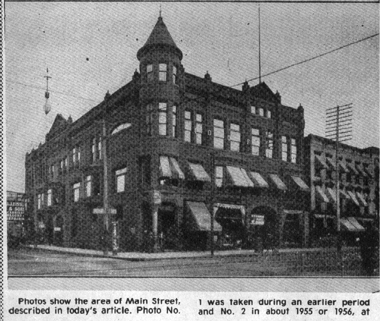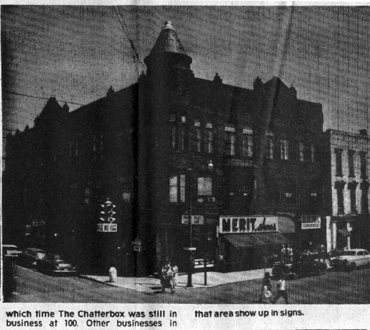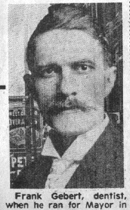June 25, 1981



Picture #1 & #2 – Photos show the area of Main street, described in today’s article. Photo No. 1 was taken during an earlier period and No. 2 in about 1955 or 1956, at which time The Chatterbox was still in business at 100. Other businesses in that area show up in signs.
Picture #3 – Frank Gebert, dentist, when he ran for Mayor in 1909.
Only Fostorians who resided here in the early part of this century will remember how busy the uptown business district was then.
The first-floor rooms were always filled with a variety of stores, making it unnecessary for area residents to shop out of town.
Second-floor rooms were occupied by doctors, lawyers, realtors, studios, tailors and general offices. Those buildings with third-floor rooms usually accommodated lodges, athletic halls for boxing and wrestling, struggling new churches, dance halls and storage areas.
The east side of Fostoria’s business district, from Center to Tiffin streets, was one of those areas, and the one to be explored today. It was a particu- larly important area since that is where the electric interurban stopped to take on and leave off passengers.
The Alcott Block, once located at the corner of Center and Main, was one of Fostoria’s finest buildings. It is at that point where our historical trip backwards starts. That building was built by Captain Roger Alcott in 1893, his title coming from being captain of the Fostoria Light Guards, which later became Co. I, 164th Ohio Volunteer Infantry.
ALCOTT A TELEGRAPHER
Alcott, born in Toledo in 1837, spent his boyhood there, coming here from Fremont, where he was a telegrapher for the Western Union. He bought Mr. Bements’ store and tin business, which was located in a frame building where the Alcott Block was later built.
Having been a telegrapher, Alcott opened a telegraph office in his building, the first telegraph office here. Unlike later equipment, the Morse code dots and dashes were made on strips of paper, instead of by sound.
The building Alcott purchased was one of Fostoria’s landmarks, built in 1845 by H. Cover, and used by him as a residence for several years. He later sold it to Jacob Baer, who resided in it. Then it became a boarding house, run by a William Bates. Next Bement had his tin and stove business in it. At about the same time, the property was also used by J. B. Van Dorn as a drug store, one of Fostoria’s earliest.
In 1891, the landmark building of the 1850’s was sold to Ira Cadwallader and moved to the northeast corner of North and Cadwallader Streets. It became the O. C. (Ohio Central) Hotel, named that because the Ohio Central railroad was just east of it. It was used as a hotel for a number of years, when Fostoria was booming. Later a man named Steiger had a dray and storage business there, and still later it was made into residential apartments.
Today, the old building having been demolished many years ago, the site is the Gray Printing Co. parking lots, and the O. C. Depot is a Gray warehouse.
So, in 1893, after the old building where Captain Alcott started business was removed, he built the impressive building named after him. It was destroyed by fire in 1962. But that wasn’t the first fire that threatened the Alcott Block.
In 1897, four years after the Alcott Block was completed, a barrel of asphaltum being emptied in the basement, exploded. Fire from the explosion did $10,000 damage to the new structure.
As opposed to the disastrous fire of 1962, the firefighters contained the one in 1897 to the Alcott Building, thus saving the Hays Hotel next to it. The Alcott building was completely restored after the 1897 fire.
Those occupying space in the Alcott building from 1893 to 1897, according to historical records, were: Alcott Hardware Co., American Express Co.; Robin- son Bros. & Co. Jewelers, in the corner room, F.A. Mabery; J.F. Richard & Son, restaurant; Dr. C.S. Green; the City Waterworks Office; The Columbian Club; Dr. Frank Gebert, dentist; Dr. Hendershott, Vogel Bros., tailors; Odd Fellows Lodge and Lafe Arnold’s barbershop.
The Alcott Block abutted the one which is today occupied by The Review Times, on the east, and by the Hays Hotel building which was to the south.
HAYS BLDG. EARLY ONE
The Hays House building is said to be the third building to be built in Fostoria, according to historical records. It was built by James Hays in 1844, prior to the time the two villages of Rome and Risdon joined to form Fostoria. The Hays building was also said to be one of the oldest hotels in northwestern Ohio.
It burned in 1849, then a second structure was built later that year by Thomas Hays. It was a brick structure and formed a part of the building that was added to it in later years by David Hays, and the same one that was part of the disastrous fire in 1962.
So much for that early history. The following list provides names of merchants, professionals and others occupying the Alcott Block from 1915, the earliest date when directories provided listings for easy extraction according to streets.
Moving south, from Center, the first number in that block in the east side is “100.”
NUMBER 100
George Abowd, assisted by his wife, Josephine, and sons, Richard and Abraham, had a confectionery store there for many years, starting in 1908. In addition to candy, ice cream, peanuts, popcorn, they also had fruits and to- bacco.
In later years, when George Abowd had passed away, the store was continued for a time, but in 1929 was purchased by Robert Fruth and operated under the name of The Golden Pleasant for about two years. He then sold it to Joe Corl who continued it under that name until 1947, when it was sold to Ralph and Harold Cockrell who renamed it The Chatterbox. They continued to operate it until about 1956. First and second generation Abowds are all dead, as is Joe Corl. Bob Fruth still resides on West Jones Street in Fostoria. Of the Cockrell brothers, only Harold is living, in Cleveland; Ralph’s widow is in Fostoria.
Earl “Skeet” Green, Fostoria’s veteran candymaker, deceased, who learned his trade under George Hayden, continued to make candy for Bob Fruth when he had his store.
BASEMENT
The basement under “100” was a barbershop for many years, the earliest being Lafe Arnold. W.R. Sprague had a shop there for many years, followed by Oscar Daymude with both barber and beauty parlor, operated by his wife and daughter, Wanda. Cliff Stocker was there when the building burned in 1962.
UPSTAIRS
The corner room on the second floor was occupied, as long as I can remember, by Dr. Frank and Orlo Gebert, dentists (father and son). First the father, then the son, wre my dentists from boyhood, until Orlo retired. I can still recall the sound of the foot operated drill. The father always hummed when working on patients to take their mind off of the drilling. The son usually talked about various things to occupy the patients.
Others on the second floor at various times were: E.C. and A.C. Lloyd, insurance; Dr. C.S. Green, M.D.; R.C. Guernsey, attorney; C.C. McKay, attorney; Fostoria and Fremont Interurban offices; Dr. I.L. Briggs, M.D.; Dr. W.R. Spooner, M.D.; Dr. T.W. Geohegan, M.D.; Loan & Finance Co. (Austin Potter); R.P. Kabel, insurance, stocks, bonds; Dr. N.C. Hatfield, M.D.; J. Nicholas Kiebel, optometrists; Elks Lodge.
To the best of my knowledge, all of the above persons are deceased. Dr. C.S. Green’s home still stands on West Tiffin Street…the brick structure, just west of Ohio Savings & Loan.
THIRD FLOOR
That floor of the Alcott Block had various occupants through the years. The ones I can recall are Independent Order of Odd Fellows and Loyal Order of Moose. Also, dances and wrestling matches were sometimes staged there.
One of the favorite local wrestlers was Al Ackerman, a baker by trade, but dangerous in the ring, especially if his opponents were “dirty.” On those occasions, Al had plenty of tricks and superior strength to handle them.
NUMBER 102
That location was a favorite for hardware stores. Roger Alcott was the first. D.R. Balmer, who had been associated with Alcott later took over the business. His store was mentioned in detail in “Potluck” of July 17, 1980, along with photos.
Later Rothrock-Pifer Hardware was there: The Fostoria Hardware, operated by Arthur Wyant, was the last hardware store in that room.
That location was then taken over by Merit Shoe Store, as the one accompanying photo indicates.
NUMBER 104
That business room had a variety of stores through the years, a popular spot for shoes. One of the early ones was Parks & Lamphear Shoe Store; later Peter Shoes. Abe Peter being the proprietor.
Bill Stump and Harold Pets had a poolroom and news-magazine agency there at one time, and later George Jackman had his Fostoria Electric Store.
At 100, 102 and 104 were the only other three business rooms in the Alcott Block on Main Street. However, on the Center Street side of the building, there was another entrance for access to the upper floors and four more business rooms. More about those later.
When fire destroyed the Alcott Block that was an unfortunate incident which changed that area of Main Street, and necessitated merchants, professionals and other tenants to fine new locations.
As a finis to today’s installment, it should be added that Roger Alcott died Aug. 5, 1905, of peritonitis, having been in poor health for several years. (Continued next week.)
1962 FIRE DESTROYED ALCOTT, HAYS BUILDINGS
The fire that destroyed the Alcott Block and Hays Hotel building in 1962 was believed to have started in the Hays Bar. It was said to be the most disastrous fire in the city’s history, with damages exceeding $500,000.
Firemen were called at about 3:15 a.m., when Allen Kimble, driving past the Hays Hotel, spotted the fire and reported it to the police. By 4 a.m., nearly the complete interior of the Hotel was gutted and the fire had spread to the Alcott Block.
Fire departments from Tiffin, Findlay and Fremont responded. Twenty-six fire- men, including 10 from out-of-town, battled the blaze until mid-morning before the fire was extinguished.
Fifteen businesses suffered damage, including Allen Burger’s Shoe Store, Ash Hat Shop, Fostoria Electric, Merit Shoe Store, Two Guy’s Barber Shop, Hedges Cleaners, Cliff Stocker Barber Shop, Guernsey & Guernsey Law Offices, Moos Lodge, Lester C. Huth, attorney, Kinn & Theobald Insurance, Block Income Tax Service, Brown’s Collection Agency, Beneficial Finance Co., and The Review Times.
REVIEW TIMES SAVED
At one time The Review Times wasn’t sure if they would be able to publish that day. Firemen broke out the skylight of The Review Times building to enable them to gain access to the roof and pour water on the roof of the Alcott Block, Mel Baxter, RT plant superintendent, assisted by Al Hammer, still employed at the RT), assisted in keeping the hoses applying water and kept the fire from spreading to the RT.
The Hays Hotel had been closed for about a year, only the bar being in operation. Burger’s had made plans to close and the hat shop had partially vacated at time of the fire.
Just a week before the fire, James Tsantles, one of the Hays building owners had announced it would be demolished and a new building erected.
The Hays Hotel, at that time was the oldest in northwestern Ohio, the original section having been built in 1846, eight years before Rome and Risdon joined to become Fostoria.